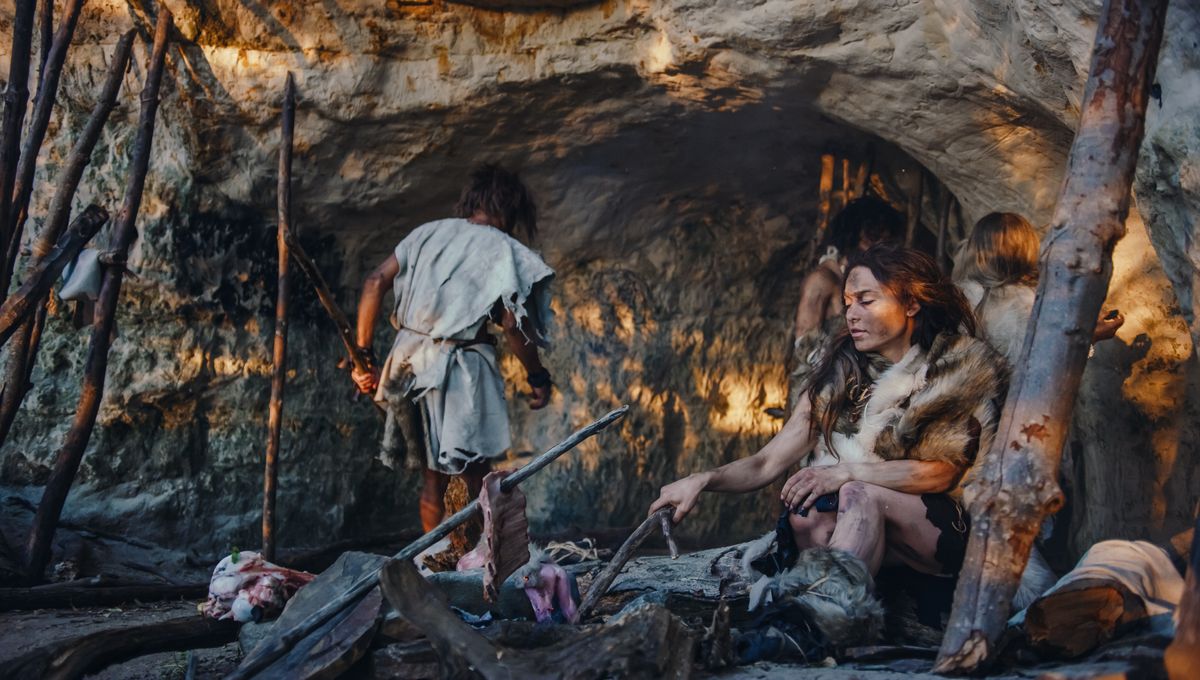
If someone says “Neanderthal” to you, what’s the first thing that pops up in your head? If it happens to be an image of a “caveman”-esque person, it wouldn’t be all that surprising. A quick image search brings up results mostly showing male Neanderthals – but what about the females of the species? What do we know about them and how they lived?
Leaving home?
With limited research in the area, it’s difficult to know much about the early years of a female Neanderthal’s life. However, when it comes to progressing towards adulthood, there are some clues.
For example, there’s a mutation from Neanderthals present in some humans today that is thought to cause earlier onset of menarche – the first menstrual cycle or period. This suggests that female Neanderthals may have started their periods and reached maturity (at least in the reproductive sense) at an earlier age than is typically seen in humans today.
As they got older, they may well have also taken on sexual partners or mates. If they did find a mate, a small study suggests that female Neanderthals may have moved from their own community to their partner’s.
Researchers analyzed the genomes of Neanderthal individuals whose remains were found in two different Siberian caves for clues as to their social organization. This included the sequence of Y chromosomes, which are passed down from fathers, but they also looked at the maternally inherited mitochondrial DNA.
From this, they found that there was more diversity in the mitochondrial genome than in Y chromosome DNA, which the researchers suggest is “best explained by female migration between communities.”
However, the team only presented the genetic data of 13 individuals; more samples would be required to make any solid conclusions about whether or not female Neanderthals did in fact move away from their original communities.
Painful childbirth – but they may have had help
Regardless of where they ended up staying, at some point many female Neanderthals would’ve ended up with a cute (ok, on this part we’re guessing) little Neanderthal baby – although we now know it could also have been half Homo sapiens. Even for present-day humans, the experience of getting a baby out of you can be something of a mixed bag, but what was childbirth like for Neanderthals?
Probably just as painful and difficult as it is today, according to researchers from the University of California at Davis and the Max Planck Institute for Evolutionary Anthropology. Using computed tomography scans, researchers created a virtual reconstruction of a Neanderthal pelvis; specifically, that of a female found in the Tabun cave.
The reconstruction suggests that the birth canal of a female Neanderthal was quite different from that of a modern human; it was widest from side to side and did not twist. This lack of twisting indicates that babies may not have rotated in the womb (though not everyone is convinced), although that doesn’t mean childbirth was any easier back then.
Neanderthal babies may have had slightly bigger, longer heads, so a big ol’ baby noggin plus a relatively small area from which to enter the world would still have equaled a whole lotta ouch.
Thankfully, they may have had people at their side to get through it. A 2019 study puts forward that Neanderthals had healthcare practices – and according to lead author Dr Penny Spikins, that could have extended to something akin to midwifery.
“It is likely that they would have had assisted childbirth; the role that we now attribute to midwives,” said Spikins in a statement. “Without support, they probably could not have survived the toll that the death rate of mothers and babies could have taken on their communities.”
“Hunting belonged to everyone”
Beyond giving birth to the next generation of Neanderthals, what was the role of females within their communities? Although it’s hard to say for certain, evidence suggests that it may not have been all that different from the male members of the species.
Trauma to the bones reflecting a life of hunting has been found in the fossils of both male and female Neanderthals, as has evidence of tooth wear indicating both sexes partook in activities where teeth were used as an extra hand, such as hide-working.
According to assistant professor of anthropology Cara Ocobock, that probably didn’t change with parenthood either. “[W]e have no reason to believe that prehistoric women abandoned their hunting while pregnant, breastfeeding or carrying children,” said Ocobock in a statement, “nor do we see in the deep past any indication that a strict sexual division of labor existed.”
Hunting “belonged to everyone, not just to males.”
Of course, without a time machine, it’s difficult to know exactly what the life of a female Neanderthal was like – it’d be easier to say what they couldn’t do, like go to a supermarket or subscribe to IFLScience’s YouTube channel. But from what little evidence we have, it paints a picture with many differences, and a few similarities, to what is seen in their distant relatives today.
Source Link: What Was Life Like For Female Neanderthals?